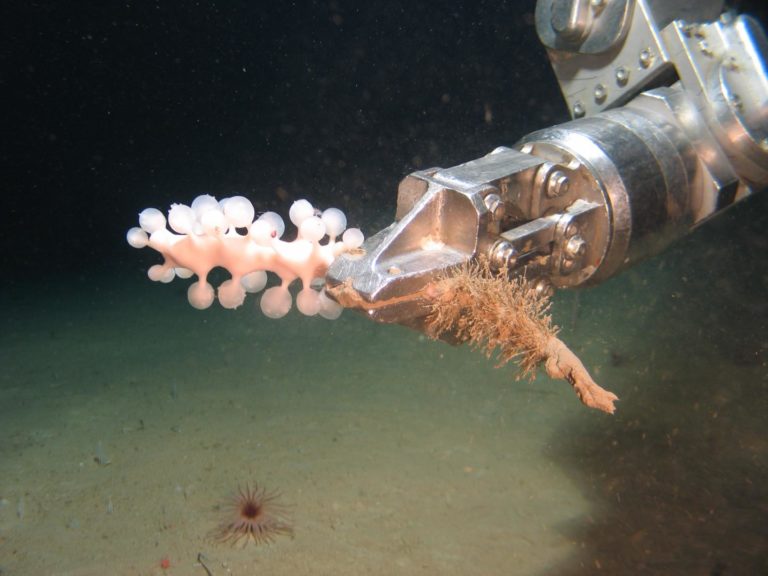Fan Cheng New sensors for underwater vehicles can benefit scientific research and industrial man
Published on:2020-04-21
The oil and gas industry regularly uses underwater robots to inspect and maintain offshore structures. A study led by Australian researchers concluded that with additional sensors, these systems can also collect data on Environmental Science and resource management.
Led by Dianne McLean and miles Parsons of the Australian Institute of Marine Sciences (AIMS), scientists around the world have urged closer links between industry and researchers to maximize the benefits of underwater robots, namely remotely operated vehicles (ROVs).

Underwater vehicles can provide value in many fields
In a paper published in the journal frontier of marine science, they confirmed that sensors can be easily added to a range of instruments on board ships, including cameras, tape recorders and sample collectors.
They said that the information collected could greatly enhance the understanding of the scientific and industrial community on the impact of marine infrastructure and play a role in ecological management and regulatory compliance.
"Its a real win-win," Dr. McLean said. "Through some low-cost engineering and operational adjustments, industry and the scientific community can use ROV to promote new scientific discoveries. For example, we can better understand the impact of structures such as platforms and pipelines in marine ecosystems, so as to make resource companies and the environment mutually beneficial."

ROV with arm for collecting marine samples. Source: aims
The research of underwater vehicles has been expanded
The new study builds on an earlier study that used a modified underwater robot to detect fish populations around a Northwest continental shelf platform 138 kilometers (85.7 miles) off Dampier, Australia
Next month, the aims team will expand the scope of the study and work with Santos Ltd. to use ROV to investigate marine life around shallow water platform jackets. The airship is regularly used to inspect thousands of industrial seabed structures around the world every year. They operate in shallow water to a depth of 3000 meters (9842.5 feet).
McLean, a fish ecologist and underwater video system expert, and Parsons, an acoustic expert, worked with colleagues in Australia, the United States, the United Kingdom and Scotland to find feasible and cost-effective ways to produce standard work level ROVs to adapt and expand their data collection capabilities.

A magnum remote-controlled submersible for ocean engineering, with a time-delay camera on the functional arm (right). Source: aims
These measures include the addition of additional sensors, cameras, acoustic transmitters and receivers, and sample collection devices. "By working with experienced research scientists, industry can improve the quality of its ROV data." Parsons said.
Small sensors are enabled and bring great benefits through cooperation
This information can be useful when complex engineering and environmental management challenges are involved, such as the decommissioning of large structures at the end of their service life. From an industry perspective, small ROV sensors can be used for scientific investigation, improve environmental management, and promote informed communication with external stakeholders such as regulators and the public. Research shows that in the long run, small improvements to ROVs and their current use can bring huge benefits to science and resources companies.
Led by Dianne McLean and miles Parsons of the Australian Institute of Marine Sciences (AIMS), scientists around the world have urged closer links between industry and researchers to maximize the benefits of underwater robots, namely remotely operated vehicles (ROVs).

Underwater vehicles can provide value in many fields
In a paper published in the journal frontier of marine science, they confirmed that sensors can be easily added to a range of instruments on board ships, including cameras, tape recorders and sample collectors.
They said that the information collected could greatly enhance the understanding of the scientific and industrial community on the impact of marine infrastructure and play a role in ecological management and regulatory compliance.
"Its a real win-win," Dr. McLean said. "Through some low-cost engineering and operational adjustments, industry and the scientific community can use ROV to promote new scientific discoveries. For example, we can better understand the impact of structures such as platforms and pipelines in marine ecosystems, so as to make resource companies and the environment mutually beneficial."

ROV with arm for collecting marine samples. Source: aims
The research of underwater vehicles has been expanded
The new study builds on an earlier study that used a modified underwater robot to detect fish populations around a Northwest continental shelf platform 138 kilometers (85.7 miles) off Dampier, Australia
Next month, the aims team will expand the scope of the study and work with Santos Ltd. to use ROV to investigate marine life around shallow water platform jackets. The airship is regularly used to inspect thousands of industrial seabed structures around the world every year. They operate in shallow water to a depth of 3000 meters (9842.5 feet).
McLean, a fish ecologist and underwater video system expert, and Parsons, an acoustic expert, worked with colleagues in Australia, the United States, the United Kingdom and Scotland to find feasible and cost-effective ways to produce standard work level ROVs to adapt and expand their data collection capabilities.

A magnum remote-controlled submersible for ocean engineering, with a time-delay camera on the functional arm (right). Source: aims
These measures include the addition of additional sensors, cameras, acoustic transmitters and receivers, and sample collection devices. "By working with experienced research scientists, industry can improve the quality of its ROV data." Parsons said.
Small sensors are enabled and bring great benefits through cooperation
This information can be useful when complex engineering and environmental management challenges are involved, such as the decommissioning of large structures at the end of their service life. From an industry perspective, small ROV sensors can be used for scientific investigation, improve environmental management, and promote informed communication with external stakeholders such as regulators and the public. Research shows that in the long run, small improvements to ROVs and their current use can bring huge benefits to science and resources companies.

